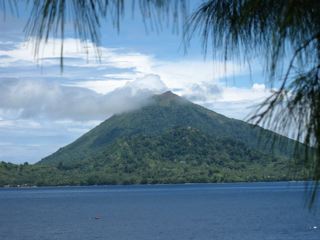Fw: Spice Islands Festivities

Storyteller
Sun 1 Aug 2010 00:13
|
Position 04.31S 129.53E
Four days after leaving Darwin we arrived at Bandaneira, the capital of the
tiny Banda Islands, previously known as the Spice Islands. Of all the places we
have visited, this is possibly the most beautiful and certainly the most
colourful, with the village only 200 metres away and Gunung Api volcano looming
on the opposite shore.
Although we were accompanied on the trip from Darwin by two
Indonesian patrol boats, nothing prepared us for the welcome on our arrival,
which probably happened because this is an area that normally receives little or
no tourism. This is despite the fact that the landscape is Bali Haiish,
there is a vibrant local culture, and many very visible remains of over 300
years of Dutch rule. The blissful lack of tourism (well blissful for us but not
the local economy) is due to the fact that there is almost no transport to the
Bandas, very little accommodation, and a sad recent history of sectarian
violence against the local Christian population. We were quite shocked yesterday
to meet one of the survivors of the 1999 massacre and to see the graves of his
family.
Bandaneira is no stranger to atrocities, unfortunately, both from the Dutch
East India Company, which in 1621 slaughtered the majority of the local
population, then the Japanese in World War 2. Remarkably, the local people show
no signs of bitterness and are wonderfully cheerful and welcoming.
The local authorities have gone to enormous trouble to entertain the 30 or
so yachts in the Rally, including putting on numerous official functions,
traditional boat races, music, dancing, feasts of delicious local food. There
was even a hospital ship waiting in the harbour in case the Indonesian president
should arrive! This meant that several operations were performed on local
children with hare lips, something that would not have happened without our
Rally. The whole village is decorated with Sail Banda banners and the
local children love calling out in their little bits of English. We are all
picking up a reasonable amount of Bahasa Indonesia, and the locals are very
happy to help with pronunciation. Luckily it is a pretty easy language to learn
and almost identical to what is spoken in Malaysia.
Yesterday we joined up with friends on some American and English yachts and
chartered a colourful fishing boat for a day of snorkelling, diving and
site seeing on nearby islands--all for less than ten dollars per person. The
clarity of the water is the best we have seen anywhere in the world--with masses
of different coloured corals and fish.The landscape reminds us a little of a
tropical kind of Greece with some Turkish culture thrown in. We have used a
local teacher as our guide and interpreter which has made our stay much more
interesting and enjoyable. We've loved visiting the local plantations of nutmeg,
cinnamon and clove trees--the reason for the Dutch colonial rule. The scent of
clove cigarettes is everywhere, accompanied by the imams' calls to prayer.
The local Bintan beer is very cheap and very acceptable, especially when
imbibed at dusk at the bar of the colonial Dutch hotel, watching all the boats
coming and going from the nearby islands. Most of the islanders are Muslim, and
non drinkers although there are still some Christians in the area. After
the sectarian troubles of the past everyone seems to live in harmony again, with
most rivalry confined to the long korakora races we were lucky enough to
witness.
Tomorrow we will do an overnight trip to Ambon, about 250 kilometres away,
where we are expecting several more days of festivals to be held in our
honour. I suspect that by the time we reach Singapore we might be a bit danced
out. John has just returned from the Port captain's office where there were at
least nine officials behind desks to help him clear out for the next leg of the
trip. If you like bureaucracy, Indonesia is certainly the place to come.
Pictures (courtesy of crew member Barry Costa)
1. Storyteller and korakora from different islands getting ready to
race
2. One of the many troops of dancers in traditional dress.
3. Crowds of locals enjoying the festivities as much as we were
4. Nutmegs in a plantation close to the boat
5. Jungle-covered Gunung Api, which used to erupt regularly and destroy the
Dutch buildings. It
last erupted in 1988, killing several people
6. Baby with a chip- packet 'mobile'
7. Village looking down on a mosque

IMG_4525.JPG
 IMG_4552.JPG
 IMG_4577.JPG
 IMG_4596.JPG
 IMG_4637.JPG
 IMG_4642.JPG
 IMG_4649.JPG
|